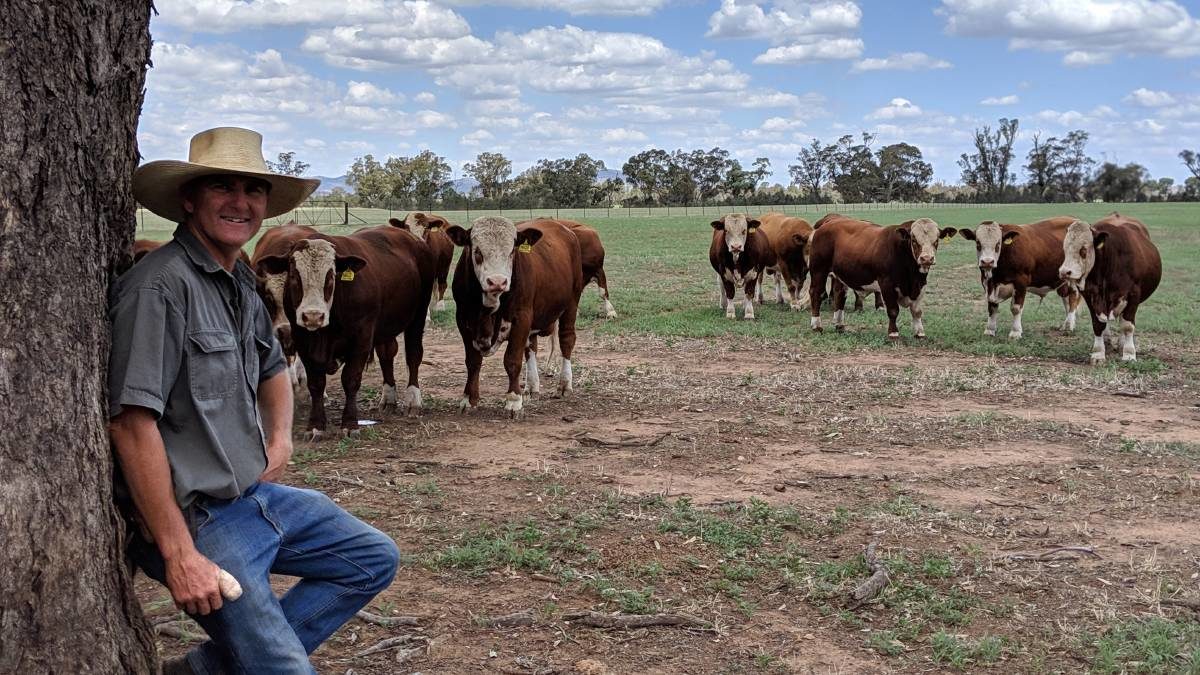(From Stock & Land, 15 January 2019)
AS one of the founding breeders in Australia, the Hopkins family of Wormbete stud will always have a passion for the traditional Simmental.
But a push from their clients who “loved what we were doing with the cattle but wanted them black”, has seen John and Nicole Hopkins of Allawah at Illabo, NSW, introduce black Simmentals and SimAngus into their herd.
They are now about 70-30 traditional and black, having purchased the Triple C stud female herd from Ian Collie, Wangaratta, which Mr Hopkins said was an enjoyable new challenge.
“We are pretty excited about what we have this year, being our biggest line-up of black bulls we’ve ever had,” he said.
“Our genetics are largely based on Bonnydale stud in WA, who I think are the most progressive black stud in Australia. Triple C was based on them so it fitted.”
The Hopkins’ goal and management are consistent for the two types, and include a strict selection criteria with a focus on softening the black genetics and maintaining a moderate frame in the traditional genetics.
“We want to breed a bull with moderate to low birth weight, that has the ability to go on and grow with sufficient softness, good temperament and fertility,” Mr Hopkins said.
They’re strict on structural correctness, and every year get Beef Xcel’s Liam Cardile to assess all sale bulls and heifers.
“It’s important to remove yourself from decisions and let someone with fresh eyes come in and be critical. You’ve seen them their whole life so a clean set of eyes to assess and catalogue is really important when you are open to feedback,” Mrs Hopkins said.
Another advancement in their breeding program had been polled genetics, she said and in terms of animal management, it was a natural progression, with 90pc of the herd polled.
“We’ve had a really clear objective this year with the dry season – we’ve only kept polled bulls at weaning,” she said.
“What we do as seedstock is not insular from what our commercial clients are doing. If we see our clients are looking for specific traits or time of year they want to purchase bull, we have to listen – it is integral part of any stud’s success.”
Wormbete also offers pregnancy tested in calf rising two-year-old heifers and weaner heifers at their annual on-property sale in March.
And having been a finalist in the Royal Agricultural Society of Victoria’s Heifer Challenge for the past five year’s running, it is no surprise they receive good demand for their female genetics.
“Breeders recognise our stud has a consistent genetic history and they are really proven,” Mrs Hopkins said.
“We are really stringent on heifers calving by two years of age. We can’t shear them so we can’t carry them.”
The 200-breeding females, plus replacements, are run alongside a self-replacing Merino flock with some prime lamb production, and a cropping operation.
Each component has its place in the operation, and with the extremely dry conditions in the past two years has meant the stock have been fed for more than 12 months.
“Breeding cattle that have do-ability is key to get through a dry season,” Mr Hopkins said.
“We weaned early, down to 100kg, which took a lot of time and effort, but it would have been a long dry cold winter for those cows to carry a calf through, so it helped both parties.
“We’ve been using a nutritionist, making use of what resources are available, and keep asking questions of people that might know something a bit extra.”
The tough season has given producers a chance to be critical of their herds, he said, which was good for the cattle industry.
“It sorts the cattle out, a year like this proves that you need to breed easy doing cattle,” he said.
Consistency of beef was one of the industry’s biggest challenges, Mrs Hopkins said, with consumers still getting large product variation.
“The advancements of genomic testing and technology and the way industry is going in mapping animals’ ability to perform in key areas should help that; it is the way the industry needs to move to stay up with it,” she said.
Opening their gates for Stock & Land Beef Week on day six, Thursday, 31 January, which Mr Hopkins said the day would expose their cattle to producers prior to sale day.

